Click here to download the Rmd file: week3-random-intercept-model.Rmd
Load Packages and Import Data
You can use the message=FALSE option to suppress the
package loading messages
# To install a package, run the following ONCE (and only once on your computer)
# install.packages("psych")
library(here) # makes reading data more consistent
library(tidyverse) # for data manipulation and plotting
library(haven) # for importing SPSS/SAS/Stata data
library(lme4) # for multilevel analysis
library(lattice) # for dotplot (working with lme4)
library(sjPlot) # for plotting effects
library(MuMIn) # for computing r-squared
library(r2mlm) # for computing r-squared
library(broom.mixed) # for summarizing results
library(modelsummary) # for making tables
theme_set(theme_bw()) # Theme; just my personal preference
In R, there are many packages for multilevel modeling, two of the
most common ones are the lme4 package and the
nlme package. In this note I will show how to run different
basic multilevel models using the lme4 package, which is
newer. However, some of the models, like unstructured covariance
structure, will need the nlme package or other packages
(like the brms and the rstanarm packages with
Bayesian estimation).
Import Data
First, download the data from https://github.com/marklhc/marklai-pages/raw/master/data_files/hsball.sav.
We’ll import the data in .sav format using the read_sav()
function from the haven package.
# Read in the data (pay attention to the directory)
hsball <- read_sav(here("data_files", "hsball.sav"))
hsball # print the data
># # A tibble: 7,185 × 11
># id minority female ses mathach size sector pracad disclim
># <chr> <dbl> <dbl> <dbl> <dbl> <dbl> <dbl> <dbl> <dbl>
># 1 1224 0 1 -1.53 5.88 842 0 0.35 1.60
># 2 1224 0 1 -0.588 19.7 842 0 0.35 1.60
># 3 1224 0 0 -0.528 20.3 842 0 0.35 1.60
># 4 1224 0 0 -0.668 8.78 842 0 0.35 1.60
># 5 1224 0 0 -0.158 17.9 842 0 0.35 1.60
># 6 1224 0 0 0.022 4.58 842 0 0.35 1.60
># 7 1224 0 1 -0.618 -2.83 842 0 0.35 1.60
># 8 1224 0 0 -0.998 0.523 842 0 0.35 1.60
># 9 1224 0 1 -0.888 1.53 842 0 0.35 1.60
># 10 1224 0 0 -0.458 21.5 842 0 0.35 1.60
># # … with 7,175 more rows, and 2 more variables: himinty <dbl>,
># # meanses <dbl>Run the Random Intercept Model
Model equations
Lv-1: mathachij=β0j+eij
Lv-2: β0j=γ00+u0j
Running the model in R
The lme4 package require input in the format of
outcome ~ fixed + (random | cluster ID)For our data, the combined equation is mathachij=γ00+u0j+eij,
- outcome =
mathach, - fixed =
1, - random =
1, and - cluster ID =
id.
Thus the following syntax:
# outcome = mathach
# fixed = gamma_{00} * 1
# random = u_{0j} * 1, with j indexing school id
ran_int <- lmer(mathach ~ 1 + (1 | id), data = hsball)
# Summarize results
summary(ran_int)
># Linear mixed model fit by REML ['lmerMod']
># Formula: mathach ~ 1 + (1 | id)
># Data: hsball
>#
># REML criterion at convergence: 47117
>#
># Scaled residuals:
># Min 1Q Median 3Q Max
># -3.0631 -0.7539 0.0267 0.7606 2.7426
>#
># Random effects:
># Groups Name Variance Std.Dev.
># id (Intercept) 8.61 2.93
># Residual 39.15 6.26
># Number of obs: 7185, groups: id, 160
>#
># Fixed effects:
># Estimate Std. Error t value
># (Intercept) 12.637 0.244 51.7Showing the variations across (a subset of) schools
# Randomly select 10 school ids
random_ids <- sample(unique(hsball$id), size = 10)
(p_subset <- hsball %>%
filter(id %in% random_ids) %>% # select only 10 schools
ggplot(aes(x = id, y = mathach)) +
geom_jitter(height = 0, width = 0.1, alpha = 0.3) +
# Add school means
stat_summary(
fun = "mean",
geom = "point",
col = "red",
shape = 17,
# use triangles
size = 4
) # make them larger
)
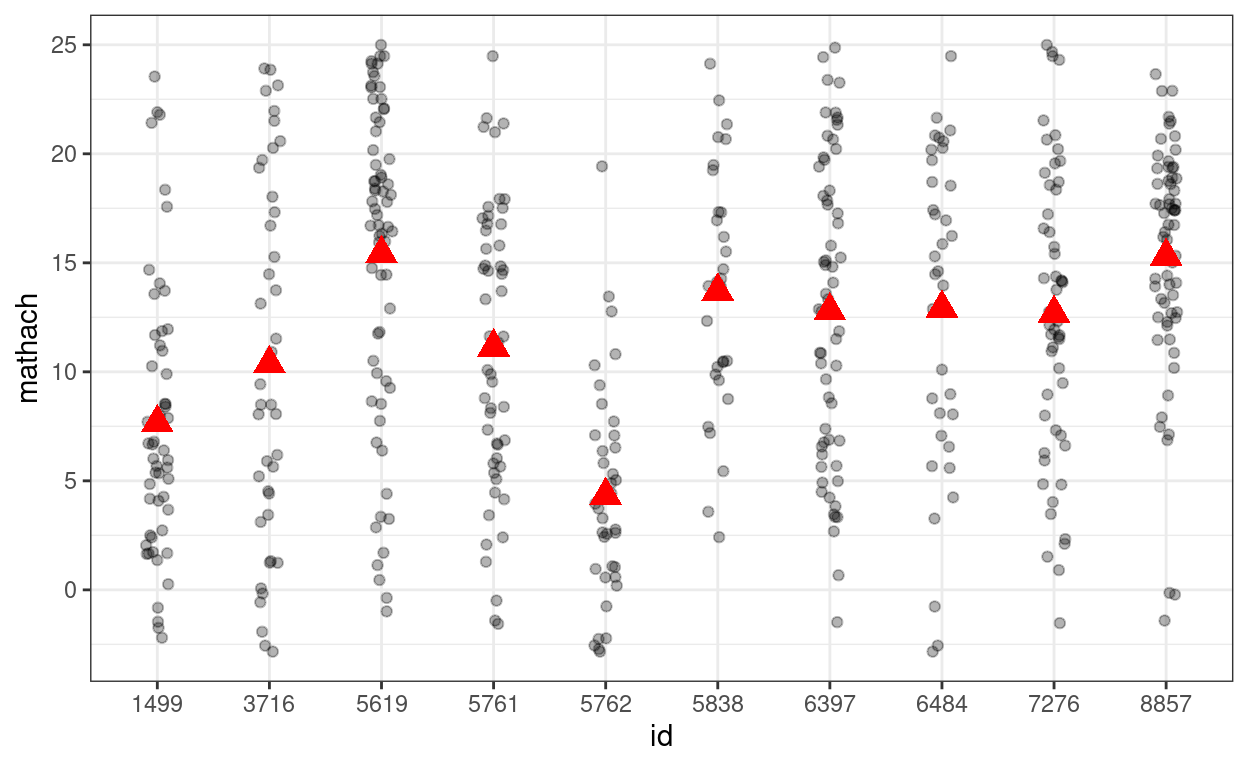
Simulating data based on the random intercept model
Yij=γ00+u0j+eij,
gamma00 <- 12.6370
tau0 <- 2.935
sigma <- 6.257
num_students <- nrow(hsball)
num_schools <- length(unique(hsball$id))
# Simulate with only gamma00 (i.e., tau0 = 0 and sigma = 0)
simulated_data1 <- tibble(
id = hsball$id,
mathach = gamma00
)
# Show data with no variation
# The `%+%` operator is use to substitute with a different data set
p_subset %+%
(simulated_data1 %>%
filter(id %in% random_ids))
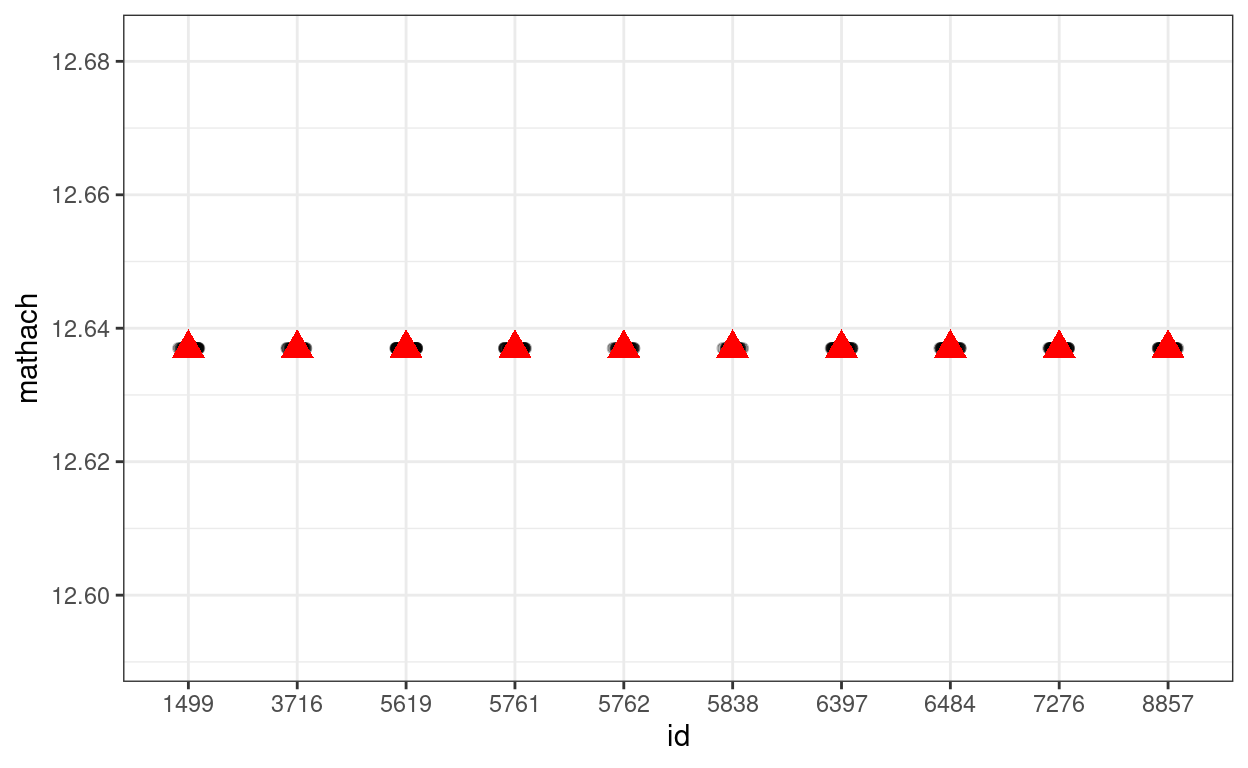
# Simulate with gamma00 + e_ij (i.e., tau0 = 0)
simulated_data2 <- tibble(
id = hsball$id,
mathach = gamma00 + rnorm(num_students, sd = sigma)
)
# Show data with no school-level variation
p_subset %+%
(simulated_data2 %>%
filter(id %in% random_ids))
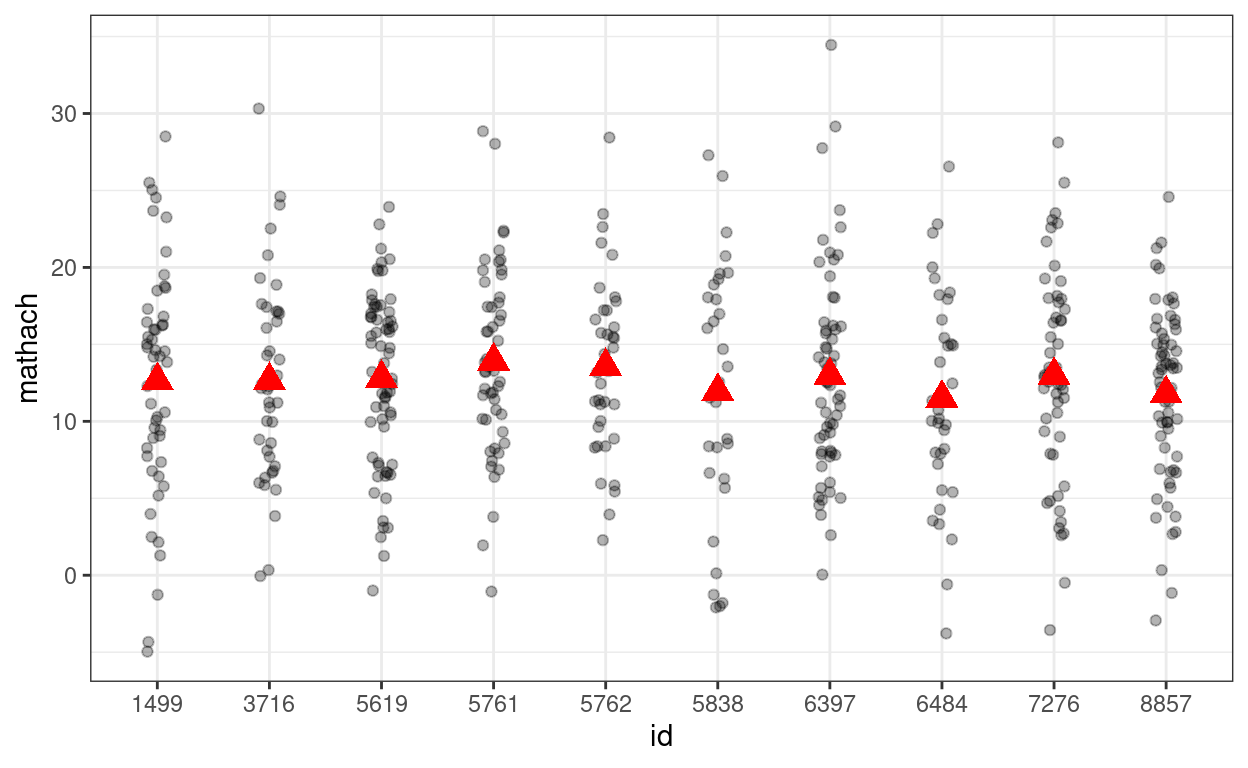
# Simulate with gamma00 + u_0j + e_ij
# First, obtain group indices that starts from 1 to 160
group_idx <- group_by(hsball, id) %>% group_indices()
# Then simulate 160 u0j
u0j <- rnorm(num_schools, sd = tau0)
simulated_data3 <- tibble(
id = hsball$id,
mathach = gamma00 +
u0j[group_idx] + # expand the u0j's from 160 to 7185
rnorm(num_students, sd = sigma)
)
# Show data with both school and student variations
p_subset %+%
(simulated_data3 %>%
filter(id %in% random_ids))
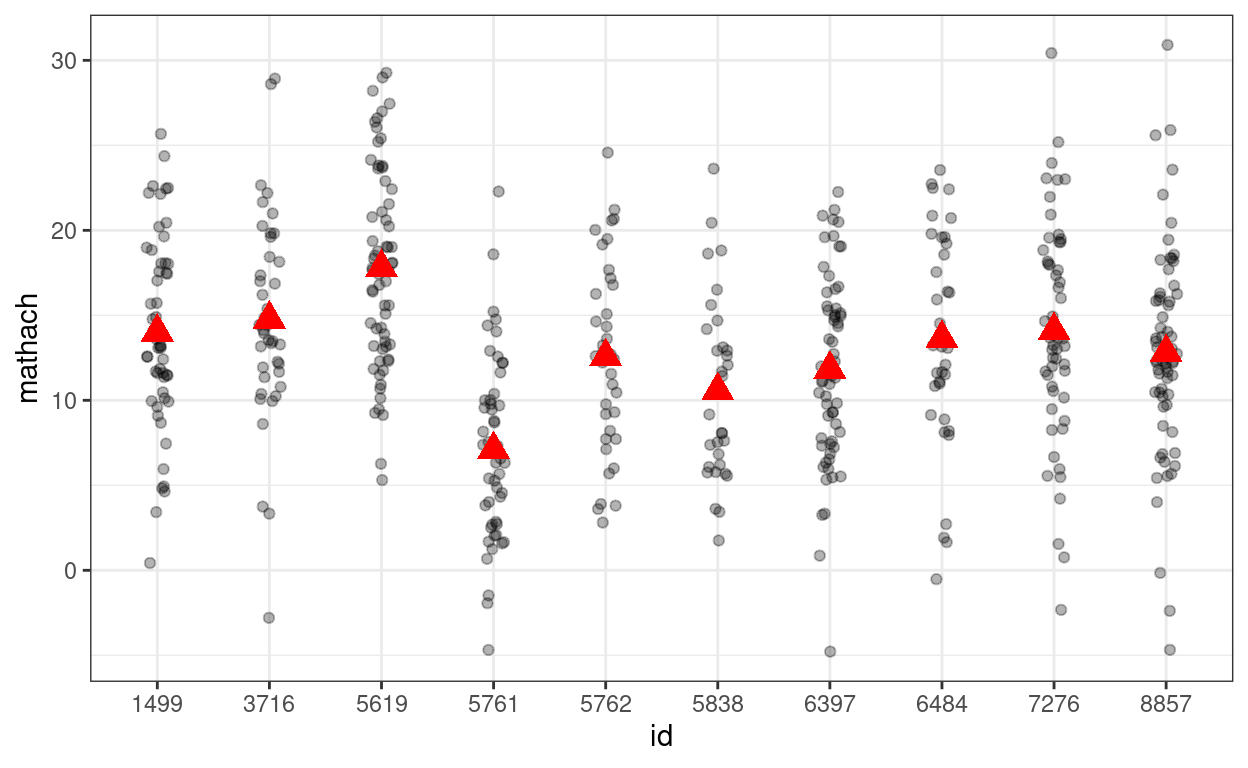
The handy simulate() function can also be used to
simulate the data
simulated_math <- simulate(ran_int, nsim = 1)
simulated_data4 <- tibble(
id = hsball$id,
mathach = simulated_math$sim_1
)
p_subset %+%
(simulated_data4 %>%
filter(id %in% random_ids))
Plotting the random effects (i.e., u0j)
You can easily plot the estimated school means (also called BLUP,
best linear unbiased predictor, or the empirical Bayes (EB) estimates,
which are different from the mean of the sample observations for a
particular school) using the lattice package:
># $id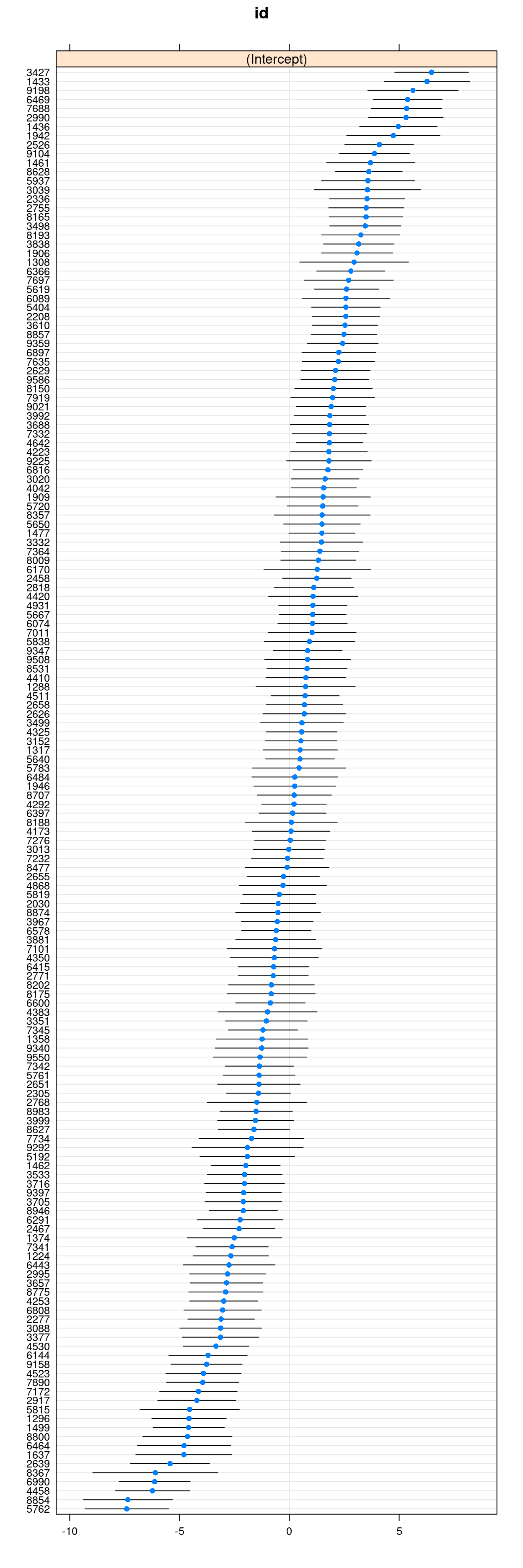
Here’s a plot showing the sample schools means (with no borrowing of information) vs. the EB means (borrowing information).
# Compute raw school means and EB means
hsball %>%
group_by(id) %>%
# Raw means
summarise(mathach_raw_means = mean(mathach)) %>%
arrange(mathach_raw_means) %>% # sort by the means
# EB means (the "." means using the current data)
mutate(mathach_eb_means = predict(ran_int, .),
index = row_number()) %>% # add row number as index for plotting
ggplot(aes(x = index, y = mathach_raw_means)) +
geom_point(aes(col = "Raw")) +
# Add EB means
geom_point(aes(y = mathach_eb_means, col = "EB"), shape = 1) +
geom_segment(aes(x = index, xend = index,
y = mathach_eb_means, yend = mathach_raw_means,
col = "EB")) +
labs(y = "School mean achievement", col = "")
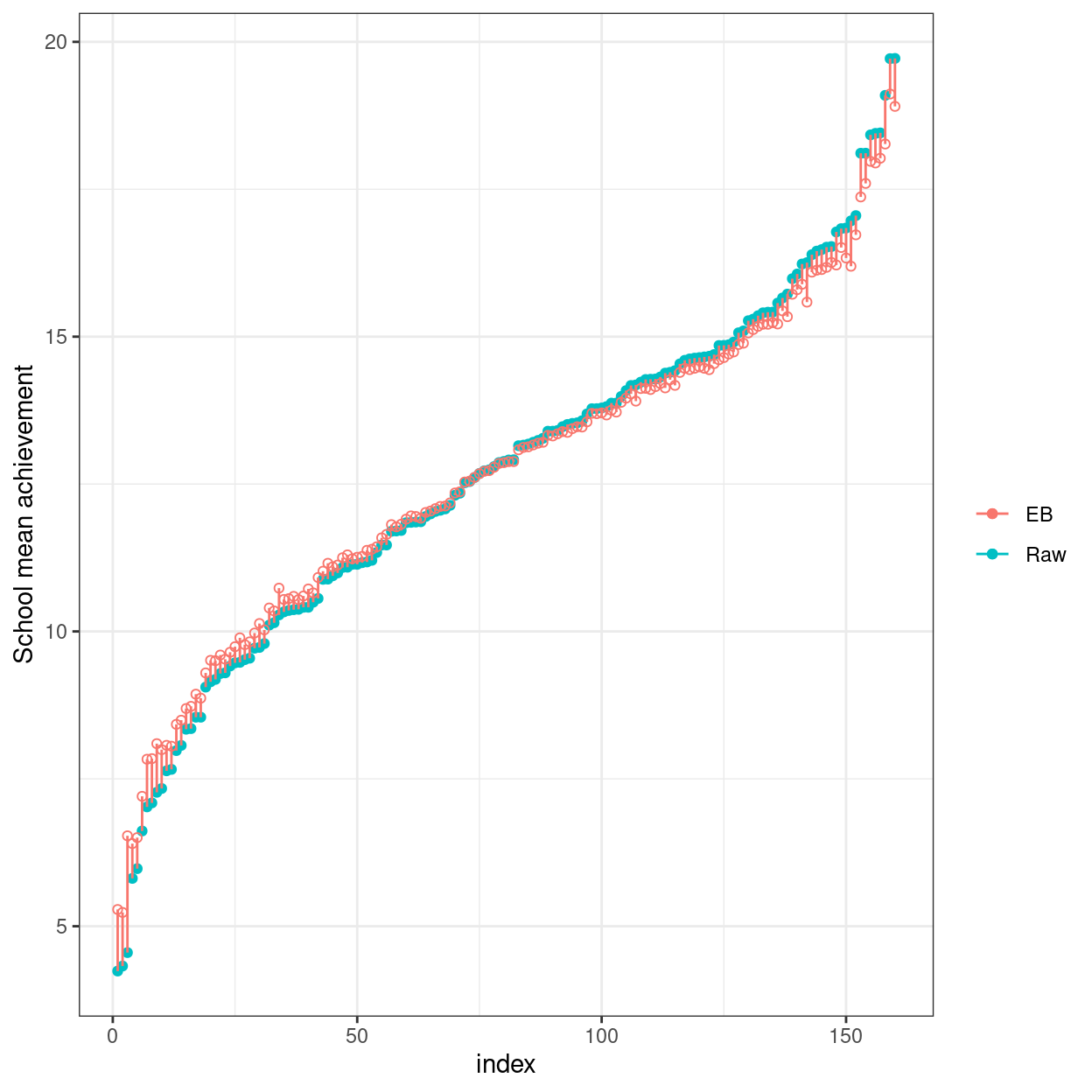
Intraclass correlations
variance_components <- as.data.frame(VarCorr(ran_int))
between_var <- variance_components$vcov[1]
within_var <- variance_components$vcov[2]
(icc <- between_var / (between_var + within_var))
># [1] 0.1804# 95% confidence intervals (require installing the bootmlm package)
# if (!require("devtools")) {
# install.packages("devtools")
# }
# devtools::install_github("marklhc/bootmlm")
bootmlm:::prof_ci_icc(ran_int)
># 2.5 % 97.5 %
># 0.1472 0.2210Adding Lv-2 Predictors
We have one predictor, meanses, in the fixed part.
hsball %>%
ggplot(aes(x = meanses, y = mathach, col = id)) +
geom_point(alpha = 0.5, size = 0.5) +
guides(col = "none")
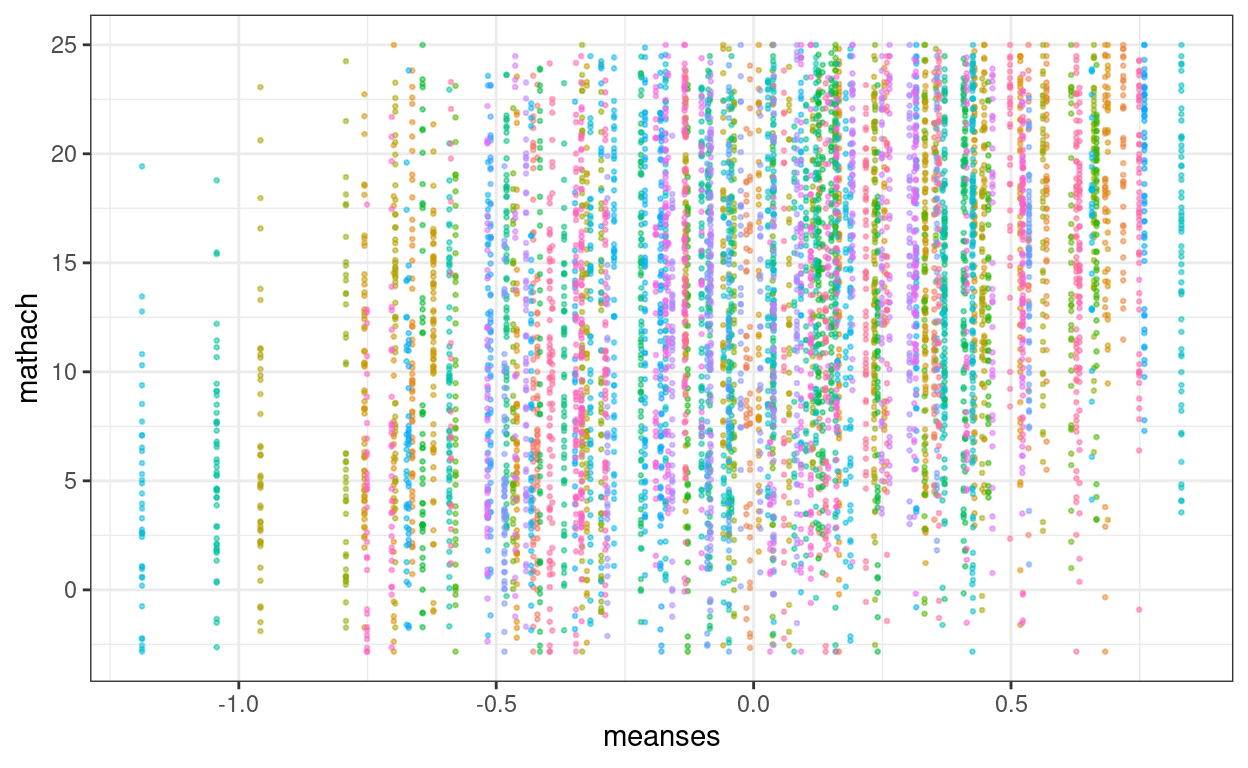
Model Equation
Lv-1:
mathachij=β0j+eij
Lv-2:
β0j=γ00+γ01meansesj+u0jmeanses that represents the
expected difference in school mean achievement between two schools with
one unit difference in meanses, and and u0j is the deviation of the mean of
the jth school from the grand
mean.
># Linear mixed model fit by REML ['lmerMod']
># Formula: mathach ~ meanses + (1 | id)
># Data: hsball
>#
># REML criterion at convergence: 46961
>#
># Scaled residuals:
># Min 1Q Median 3Q Max
># -3.1348 -0.7526 0.0241 0.7677 2.7850
>#
># Random effects:
># Groups Name Variance Std.Dev.
># id (Intercept) 2.64 1.62
># Residual 39.16 6.26
># Number of obs: 7185, groups: id, 160
>#
># Fixed effects:
># Estimate Std. Error t value
># (Intercept) 12.649 0.149 84.7
># meanses 5.864 0.361 16.2
>#
># Correlation of Fixed Effects:
># (Intr)
># meanses -0.004# Likelihood-based confidence intervals for fixed effects
# `parm = "beta_"` requests confidence intervals only for the fixed effects
confint(m_lv2, parm = "beta_")
># 2.5 % 97.5 %
># (Intercept) 12.357 12.942
># meanses 5.156 6.572The 95% confidence intervals (CIs) above showed the uncertainty
associated with the estimates. Also, as the 95% CI for
meanses does not contain zero, there is evidence for the
positive association of SES and mathach at the school
level.
sjPlot::plot_model(m_lv2, type = "pred", terms = "meanses",
show.data = TRUE, title = "",
dot.size = 0.5) +
# Add the group means
stat_summary(data = hsball, aes(x = meanses, y = mathach),
fun = mean, geom = "point",
col = "red",
shape = 17,
# use triangles
size = 3,
alpha = 0.7)
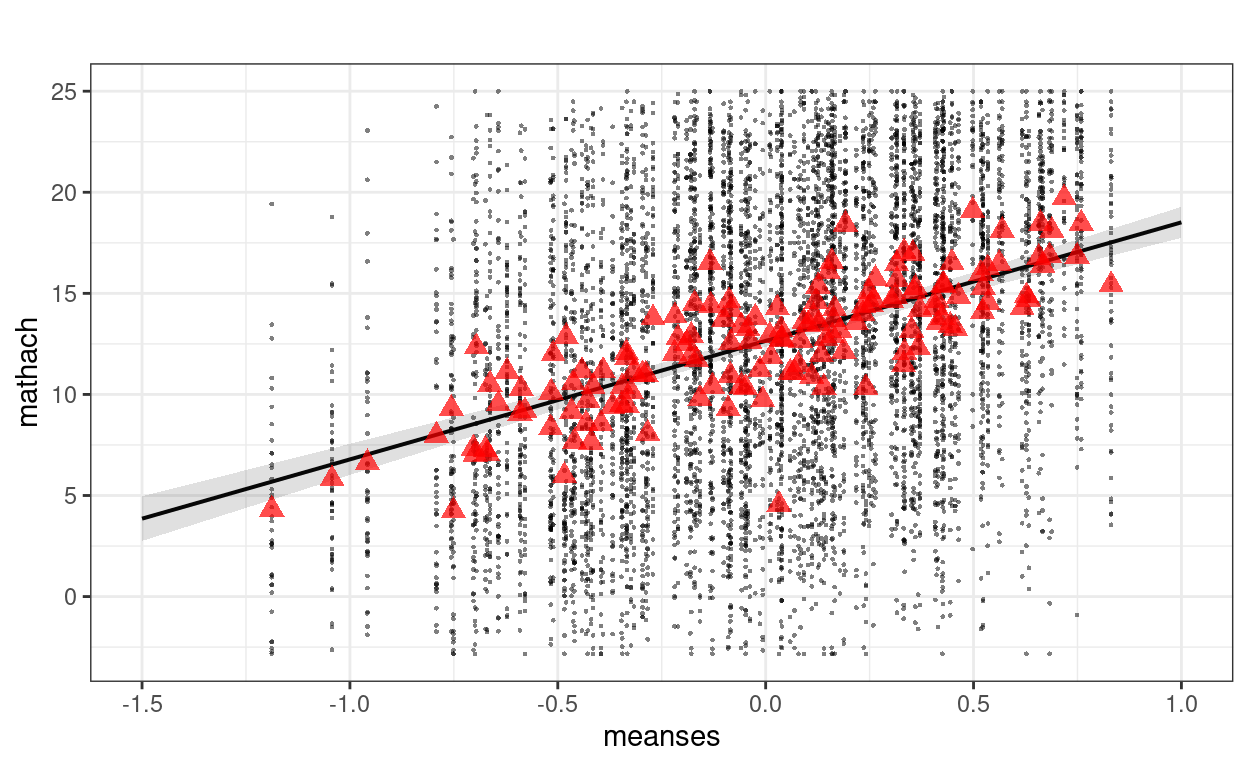
Proportion of variance predicted
We will use the R2 statistic proposed by Nakagawa, Johnson & Schielzeth (2017) to obtain an R2 statistic. There are multiple versions of R2 in the literature, but personally I think this R2 avoids many of the problems in other variants and is most meaningful to interpret. Note that I only interpret the marginal R2.
# Generally, you should use the marginal R^2 (R2m) for the variance predicted by
# your predictors (`meanses` in this case).
MuMIn::r.squaredGLMM(m_lv2)
># R2m R2c
># [1,] 0.1233 0.1787An alternative, more comprehensive approach is by Rights & Sterba
(2019, Psychological Methods, https://doi.org/10.1037/met0000184), with the
r2mlm package
r2mlm::r2mlm(m_lv2)
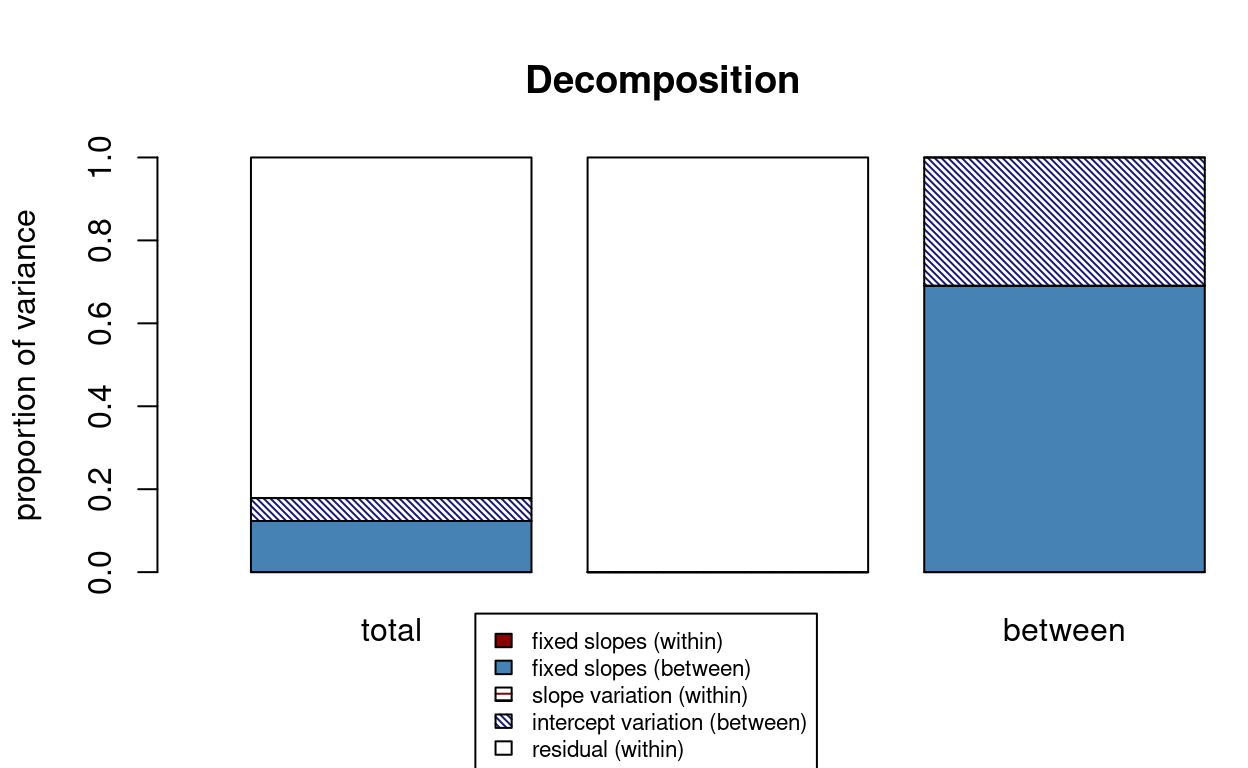
># $Decompositions
># total within between
># fixed, within 0 0 NA
># fixed, between 0.123334641367122 NA 0.690248683624938
># slope variation 0 0 NA
># mean variation 0.0553468169145697 NA 0.309751316375062
># sigma2 0.821318541718308 1 NA
>#
># $R2s
># total within between
># f1 0 0 NA
># f2 0.123334641367122 NA 0.690248683624938
># v 0 0 NA
># m 0.0553468169145697 NA 0.309751316375062
># f 0.123334641367122 NA NA
># fv 0.123334641367122 0 NA
># fvm 0.178681458281692 NA NANote the fixed, between number in the total
column is the same as the one from MuMIn::r.squaredGLMM().
Including school means of SES in the model accounted for about 12% of
the total variance of math achievement.
Comparing to OLS regression
Notice that the standard error with regression is only half of that with MLM.
m_lm <- lm(mathach ~ meanses, data = hsball)
msummary(list("MLM" = m_lv2,
"Linear regression" = m_lm))
| MLM | Linear regression | |
|---|---|---|
| (Intercept) | 12.649 | 12.713 |
| (0.149) | (0.076) | |
| meanses | 5.864 | 5.717 |
| (0.361) | (0.184) | |
| sd__(Intercept) | 1.624 | |
| sd__Observation | 6.258 | |
| Num.Obs. | 7185 | 7185 |
| R2 | 0.118 | |
| R2 Adj. | 0.118 | |
| AIC | 46969.3 | 47202.4 |
| BIC | 46996.8 | 47223.0 |
| Log.Lik. | −23480.642 | −23598.190 |
| F | 962.329 | |
| RMSE | 6.46 | |
| REMLcrit | 46961.285 |